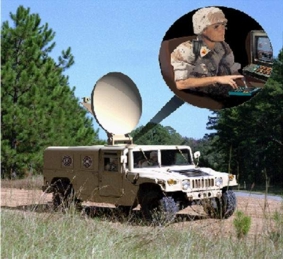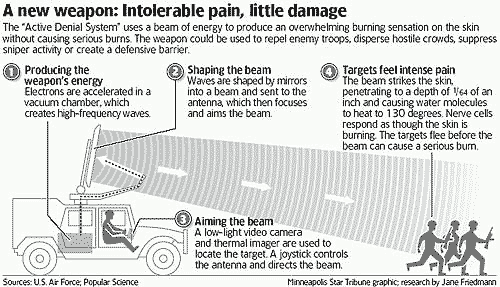
Details of US microwave-weapon tests revealed
22 July 2005
NewScientist.com news service
David Hambling
VOLUNTEERS taking part in tests of the Pentagon's "less-lethal" microwave weapon were banned from wearing glasses or contact lenses due to safety fears. The precautions raise concerns about how safe the Active Denial System (ADS) weapon would be if used in real crowd-control situations.
The ADS fires a 95-gigahertz microwave beam, which is supposed to heat skin and to cause pain but no physical damage (New Scientist, 27 October 2001, p 26). Little information about its effects has been released, but details of tests in 2003 and 2004 were revealed after Edward Hammond, director of the US Sunshine Project - an organisation campaigning against the use of biological and non-lethal weapons - requested them under the Freedom of Information Act.
The tests were carried out at Kirtland Air Force Base in Albuquerque, New Mexico. Two experiments tested pain tolerance levels, while in a third, a "limited military utility assessment", volunteers played the part of rioters or intruders and the ADS was used to drive them away.
The experimenters banned glasses and contact lenses to prevent possible eye damage to the subjects, and in the second and third tests removed any metallic objects such as coins and keys to stop hot spots being created on the skin. They also checked the volunteers' clothes for certain seams, buttons and zips which might also cause hot spots.
The ADS weapon's beam causes pain within 2 to 3 seconds and it becomes intolerable after less than 5 seconds. People's reflex responses to the pain is expected to force them to move out of the beam before their skin can be burnt.
But Neil Davison, co-ordinator of the non-lethal weapons research project at the University of Bradford in the UK, says controlling the amount of radiation received may not be that simple. "How do you ensure that the dose doesn't cross the threshold for permanent damage?" he asks. "What happens if someone in a crowd is unable, for whatever reason, to move away from the beam? Does the weapon cut out to prevent overexposure?"
During the experiments, people playing rioters put up their hands when hit and were given a 15-second cooling-down period before being targeted again. One person suffered a burn in a previous test when the beam was accidentally used on the wrong power setting.
A vehicle-mounted version of ADS called Sheriff could be in service in Iraq in 2006 according to the Department of Defense, and it is also being evaluated by the US Department of Energy for use in defending nuclear facilities. The US marines and police are both working on portable versions, and the US air force is building a system for controlling riots from the air.
“What happens if someone is unable to move away from the beam?”
www.newscientist.com/article.ns?id=mg18725095.600Microwave gun to be used by US troops on Iraq rioters
By Tony Freinberg and Sean Rayment, Defence Correspondent
www.telegraph.co.uk/news/main.jhtml?xml=/news/2004/09/19/wirq319.xml&sSheet=/news/2004/09/19/ixworld.html
 www.raven1.net/poster4.gif
www.raven1.net/poster4.gif www.cheniere.org/briefings/DoDPriore/slides/054.htm
www.cheniere.org/briefings/DoDPriore/slides/054.htm
All about HAARP
www.haarp.net/HIGH FREQUENCY ACTIVE AURORAL RESEARCH PROGRAM
Homesite
www.haarp.alaska.edu/Chemtrails DataPage
www.rense.com/politics6/chemdatapage.html